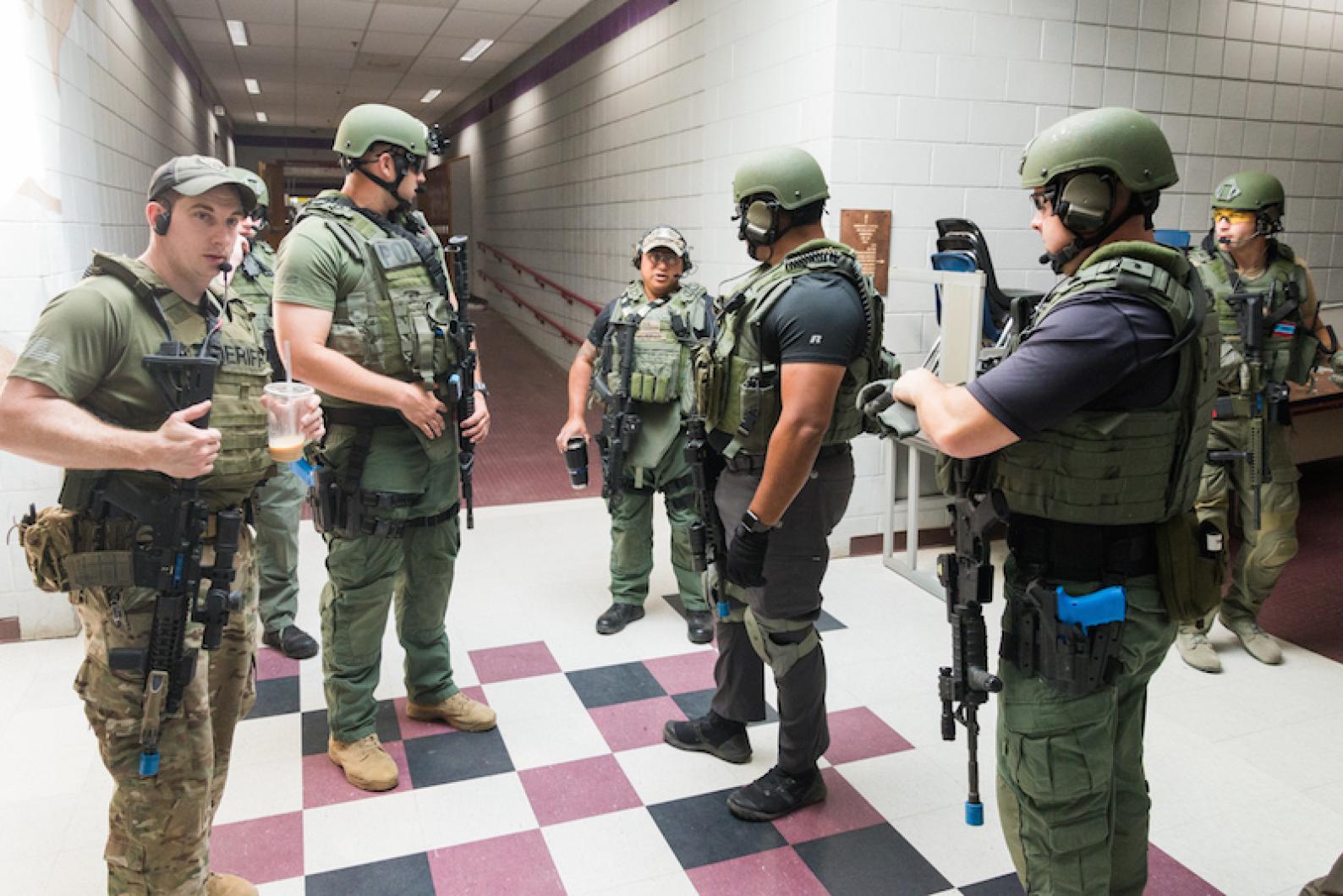Wearing bullet-proof protection and carrying simulation weapons, a tactical response team swarmed the Martha’s Vineyard Regional High School campus Thursday morning.
It was only a drill, but with heightened awareness around the country about school safety, the training exercise was not taken lightly. The drill simulated an armed intruder and hostage rescue situation and was the most comprehensive exercise the team has done to date, said James Craig, an Edgartown patrolman who leads the team.
“We need this tactical response team because other assets are hours away,” he said. “The first 20 to 40 minutes [of a crisis situation] are pretty critical.”
About 18 officers from Edgartown, Oak Bluffs, Chilmark, Aquinnah, West Tisbury, and the sheriff’s office gathered in the gym parking lot before the drill. A handful were dressed in black. They would simulate the intruder and hostages. Others wore extensive forest green safety gear including noise controlling headsets and bulky bulletproof vests. They carried bright blue simulation handguns identical in size and weight to the real thing. Rifles with plastic bullets were strapped to their chests.
Mr. Craig said much of the training gear was supplied through a recent $45,000 grant from the Department of Homeland Security. But he said despite all the weapons and safety equipment, the vast majority of crisis situations are resolved through negotiation, and the training scenarios would model that. Three trained crisis negotiators based in a mobile command unit trailer would communicate by phone with the pseudo-intruders, trying to convince them to let the hostages go.
Mr. Craig’s son Riley stood nearby wearing a protective vest. Riley, 17, is a traffic officer in Oak Bluffs, and he was set to play one of the bad guys.
“He’s been role-playing for us since he was nine,” Mr. Craig said. “We used to just say, go hide somewhere and wait for us to find you.”
He said the tactical response team trains monthly and runs scenarios quarterly.
“It’s kind of like a scrimmage,” he said. “We used my mother’s house once, but I was like, Guys don’t knock that over!”
After safety checks were complete, Capt. Greg Arpin of the sheriff’s department gathered the group to present the first scenario of the day: a hostage situation with an armed student. He said a dispatcher had received a call traced to the high school in which someone could be heard yelling, “Just give me a passing grade!” Minutes later, the fictional principal called 911 and said an armed intruder had entered the building and was holding a teacher hostage.
With the help of detectives, the negotiators obtained the intruder’s cell number and began to try to talk her down. Meanwhile, the tactical team lined up and entered the building, rifles at the ready. They moved slowly and carefully, tapping each other and signaling, never letting a person’s back go unguarded.
“Our motto is slow is smooth, smooth is fast,” Officer Craig said. “On TV they’re always kicking doors down and shouting at people. It doesn’t look like T.V.”
The tactical officers made their way through the empty school, where chairs were stacked on desks and summer maintenance work was underway, methodically sweeping each room in the science wing. They eventually arrived at a locked closet between two classrooms.
The psuedo-gunman, played by deputy Tara Simmons of the sheriff’s office, could be heard within talking on the phone with the negotiation team.
“Can I walk out of here and be sure these guys won’t shoot me?” she asked. “I’m freaking out right now.”
As the scenario directed, Deputy Simmons said her cell phone was about to die, so the communication team painstakingly negotiated a way to pass her a “throw phone,” a device connected to the mobile command unit. Two tactical officers came outside to get the phone, then brought it back and left it outside the closet for the psuedo-gunman to retrieve. They continued to stand guard outside the classroom guns ready, but this scenario would ultimately be solved through conversation.
“This is a negotiated settlement scenario,” Mr. Craig said. “Nobody should die.”
It was a peaceful summer morning, and drill participants were cheerful and focused, but the charade was also familiar in a bleak way.
Mr. Craig was among those who responded to the Boston marathon bombing in 2013. He and others searched houses in a neighborhood of Watertown one by one when of the suspects was still at large.
“The guy was found in a boat in someone’s backyard. We were searching boats in backyards too,” he said. “About half of us still on the team now were there.”
High school facilities manager Mike Taus praised the exercise. “If there is a response that needs to happen, they will have trained here,” he said.





Comments (2)
Comments
Comment policy »